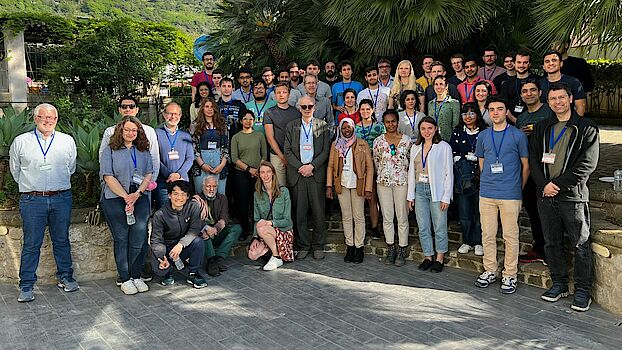/ Berichte, SNI INSight
Capri Spring School – Electron transport in a beautiful setting
Since 2015, the Swiss Nanoscience Institute has supported the Capri Spring School for doctoral students as well as several postdocs working on nanoscale electronic transport. After a two-year hiatus due to the COVID pandemic, the return of this one-week conference in May 2022 allowed 35 young researchers to benefit from the knowledge of leading international scientists. Between discussions about their research, participants also found time to discover the beautiful surroundings of the event — and to make some new contacts.
A small island and tiny objects of research
It was 18 years ago that doctoral students from across Europe first met in Capri, Italy, to exchange ideas and learn more about electronic transport processes. At this project meeting, a team of researchers led by Professor Hermann Grabert from the University of Freiburg, Germany, all of whom were collaborators in the EU project DIENOW, were so captivated by the particular charm of Capri that they established the Capri Spring School.
In 2006, Professor Christian Schönenberger was invited to speak at the conference — and was also impressed with its unique atmosphere. “I was delighted with the Spring School, which provided a relaxed, informal atmosphere where doctoral students could get together with top-class scientists. At the SNI, we therefore decided to support this wonderful, small-scale conference with a view to building up the SNI’s links on the international stage,” recalls Schönenberger.
Many more applicants than places
Today, the Capri Spring School is very well established and attracts around four times as many applications from interested doctoral students than the number of places available. “Every year, the organizing team chooses a topic,” explains Dr. Dario Bercioux (Donostia International Physics Center (DIPC) in San Sebastián, Spain), who is one of the main organizers, “and then we select the participants based on their area of work and their CV.” Only one person is allowed to attend from each working group. As word of the high quality of the Capri Spring School has got around, the conference now serves as a meeting place for doctoral students and a few postdocs from all over the world each spring.
In Capri, the participants enjoy excellent talks by leading international researchers and can even present their own research in the form of short talks and posters. Breaks and group dinners in a relaxed atmosphere offer them the chance to engage in a direct and straightforward exchange of ideas — in a way that would not be possible at a major international conference.
Two-dimensional materials
In 2022, most of the talks revolved around moiré patterns generated by two-dimensional materials. The organizers took care to offer an exciting mix of experimental and theoretical approaches, inviting researchers from Germany, Israel, Italy, Canada and the USA to speak at this year’s event. All of the speakers delivered multiple talks so that the participating young researchers could benefit as much as possible from their wide-ranging knowledge.
An ideal networking opportunity
For participating doctoral students, the Capri Spring School was the perfect opportunity to get to know other PhD students working on similar topics. This year, the event was attended by two doctoral students from the University of Basel: Alexina Ollier, an SNI doctoral student in Professor Ernst Meyer’s group, and Rounak Jha, a doctoral student working with Professor Christian Schönenberger. Both of them were delighted with the event.
“The Capri Spring School offered a unique chance to learn more about twisted bilayer graphene. It also provided an excellent opportunity to build a network of students working in a similar field and to have some discussion with the organizers and the speakers.”
Alexina Ollier, SNI PhD student in the group of Professor Ernst Meyer,
Department of Physics, University of Basel
Further information:
Web page Capri Spring School
http://www.capri-school.eu/
Video Capri Spring School 2022
https://youtu.be/zS2Op2zty58

